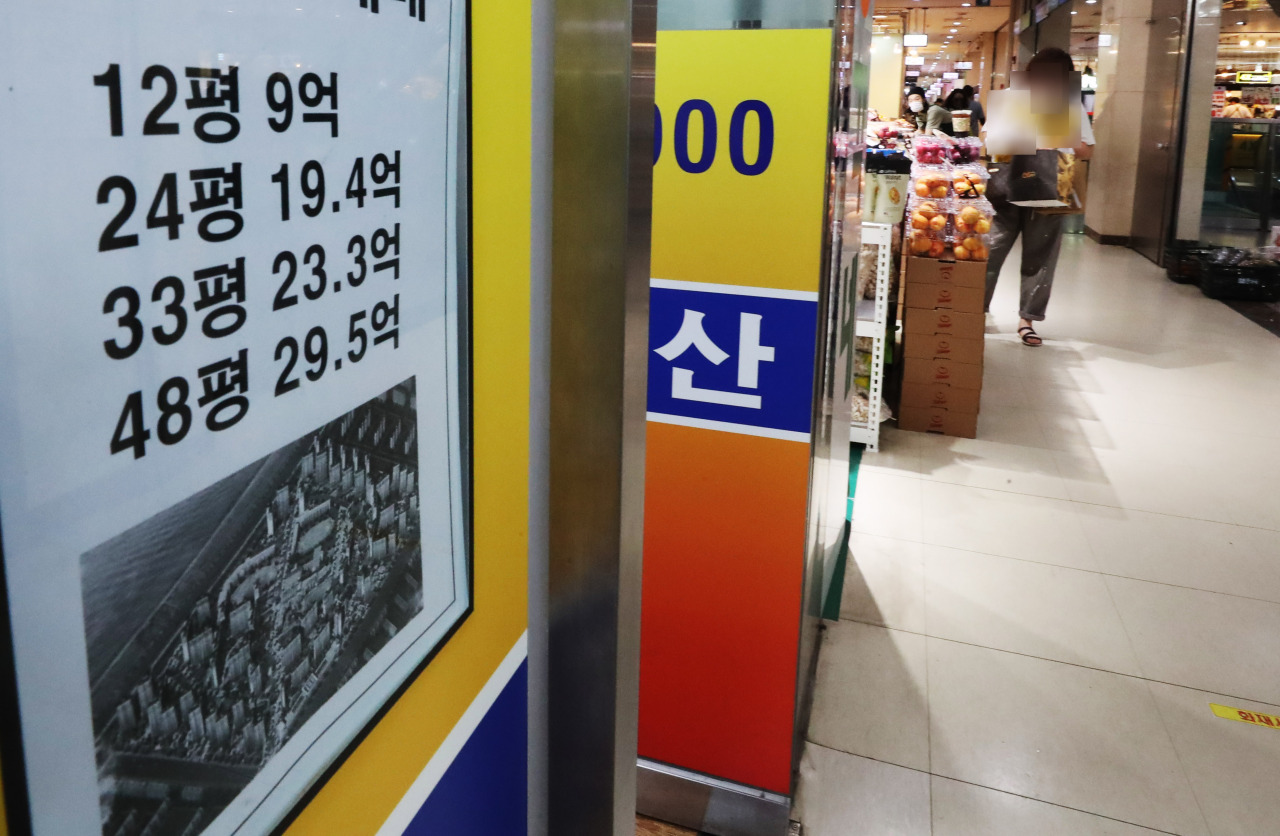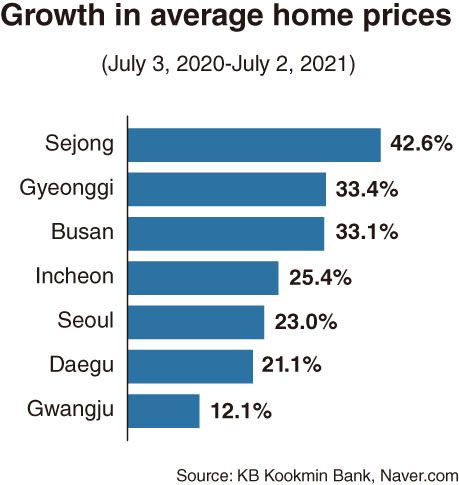[News Focus] Home prices in 9 major regions up 26% in a year
23% surge seen in Seoul, 33% in Gyeonggi
By Kim Yon-sePublished : July 6, 2021 - 15:40

SEJONG - House prices rose an average of more than 25 percent in the last 12 months in South Korea’s nine major areas, including Seoul and Gyeonggi Province.
According to KB Kookmin Bank and Naver.com, the average on-year growth in housing prices in the nine areas reached 26.7 percent during July 2020-July 2021 period. The other seven of the nine are Busan, Incheon, Daegu, Daejeon, Gwangju, Ulsan and Sejong.
Seoul saw the average trading price of homes come to 37.38 million won ($33,050) per 3.3 square meters on July 2, 2021, up 23 percent from 30.39 million won on July 3, 2020.
This indicates that the average price of an 84-square-meter unit (a popular size in the nation) in Seoul would cost 951 million won. A same-sized flat in an “apartment” building in the capital would cost far more, given that the average figure includes prices of less sought-after properties, such as those in low-rise buildings.
Seoul’s two core wealthy districts -- Gangnam-gu and Seocho-gu -- recorded rise of 18.6 percent and 17 percent over the past year to see the price per 3.3 square meters reach 65.47 million won and 63.12 million won, respectively.

This means that an 84-square-meter home would cost 1.66 billion won in Gangnam-gu and 1.6 billion won in Seocho-gu, while the prices of same-sized apartment units in the two districts are estimated at over 2.5 billion won.
Gyeonggi Province, which sounds Seoul, outstripped the capital by posting 33.4 percent growth in housing prices over the corresponding period. But the average price far fell short of that of Seoul, staying at 17.91 million won per 3.3 square meters (456 million won for the 84-square-meter units).
Nonetheless, like the price disparity among 25 administrative districts in Seoul, housing unit prices in some Gyeonggi cities were quite high, comparable to the so-called Gangnam area or higher than those of ordinary districts in Seoul.
Gyeonggi Province’s Gwacheon posted 52.43 million won per 3.3 square meters, outstripping Seoul’s Songpa-gu at 51.05 million won, Seoul’s Seongdong-gu at 42.3 million won and Seoul’s Yangcheon-gu at 40.32 million won.
Incheon, a neighboring city of Gyeonggi, also outpaced Seoul in growth with 25.4 percent. Though the home prices in the region per 3.3 square meters stood at 13 million won as of July 2, Incheon’s Songdo-dong saw the its price rise to 22.17 million won.
Sejong topped the list among the nine major regions by recording a 42.6 percent growth from 15.18 million won on July 3, 2020 to 21.64 million won on July 2, 2021.
Sejong’s “record-breaking” real estate price growth since early 2020 has recently stalled, as allegedly speculative investments by some public agency officials were uncovered earlier this year. But the future direction of home and land prices in the administrative city is still drawing nationwide attention.
Next to Sejong and Gyeonggi Province, the third-highest growth was seen in Busan, which posted 33.1 percent to 13.26 million won.
Among the next on the list were Ulsan with 26.3 percent, Daejeon with 23.4 percent, Daegu with 21.1 percent and Gwangju with 12.1 percent.
By Kim Yon-se (kys@heraldcorp.com)




![[Herald Interview] 'Amid aging population, Korea to invite more young professionals from overseas'](http://res.heraldm.com/phpwas/restmb_idxmake.php?idx=644&simg=/content/image/2024/04/24/20240424050844_0.jpg&u=20240424200058)












![[KH Explains] Korean shipbuilding stocks rally: Real growth or bubble?](http://res.heraldm.com/phpwas/restmb_idxmake.php?idx=652&simg=/content/image/2024/04/25/20240425050656_0.jpg&u=)

